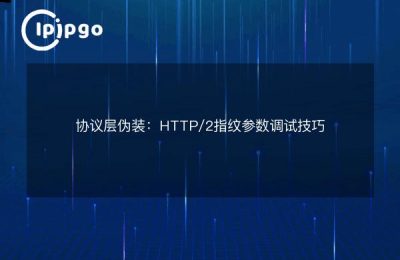
Understanding Dynamic Residential Proxy IP: A "Magic Tool" That Cannot Be Ignored
It was once said that the Internet is an endless virtual world, and all we can rely on are the tools that travel through it. Dynamic Residential Proxy IP, like that mysterious messenger wearing an invisibility cloak, quietly accomplishes the task for you, avoiding the tracking of network monitoring. As a proxy IP service provider, we know that the skill of configuring Dynamic Residential Proxy IP is not as simple as you think, it involves much more than just pressing a button.
Why should I choose Dynamic Residential Proxy IP?
In the world of the Internet, the flow of information is going on all the time, and behind this, the role of proxy IP is very important. To put it plainly, proxy IP is like your network "ID card", which allows you to hide your identity in the virtual world and complete various operations safely and reliably. Dynamic Residential Proxy IP" is one of the bright stars among proxy IPs, which is especially suitable for those who need to switch IP addresses frequently to avoid IP blocking scenarios.
Why should you choose a dynamic residential proxy IP? Because it provides a higher degree of stealth. Residential IPs usually come from the average user's home network, and "dynamic" means that these IPs are always changing. Unlike static IPs, dynamic IPs can change randomly and cannot be easily traced, which is like an invisible "ranger" that can help you avoid all kinds of network monitoring and blocking.
Dynamic Residential Proxy IP Configuration Tips: From Beginner to Expert
Okay, now that you've decided to use a dynamic residential proxy IP, how do you configure it? It's not something you can do by simply pressing a few keys like playing a game. You need to do your homework to be able to ride in this vast online world. Here, let's chat about configuration tips from a few angles.
1. Choosing the right proxy IP provider
Just like you choose the brand of your car, choosing the right proxy IP provider is crucial. Some providers offer IPs of varying quality, which may cause you frequent dropouts, request denials, and other problems. Therefore, the first step is to check whether the provider can offer stable, high-speed, and resourceful dynamic residential proxy IPs. the ideal provider not only guarantees the quality of the IP pool, but also offers flexible configuration options.
2. Configure the proxy IP pool
Once you have chosen your provider, the next step is to configure the proxy IP pool. This step is similar to filling up your "chariot" with gas, otherwise your mission will not be accomplished. By setting up the right pool of IPs, you can ensure the stability and diversity of your proxy IPs and avoid the risk of blocking a single IP due to overuse. Most of the advanced proxy IP service providers offer real-time updated IP pools to ensure that you always have the most suitable IPs available to you.
3. Use the proxy IP automatic switching function
One of the major advantages of Dynamic Residential Proxy IP is its "dynamic" nature. If your proxy IP remains unchanged for a long period of time, it is very likely that it will be detected by network targets and blocked. To avoid this, it is important to configure the "Auto Switch" feature. It's like shifting gears when you're driving a car, to keep things smooth and avoid overloading the engine. You can set the switching frequency so that the proxy IP is automatically changed to keep the operation smooth and secure.
4. Adjust proxy IP latency and bandwidth
When it comes to the Internet, speed is undoubtedly the most concerning topic. The latency and bandwidth of the proxy IP directly affect your operating experience. Too high latency may lead to slow loading of web pages or failure of requests; too low bandwidth may prevent you from smoothly carrying out tasks such as large-scale data crawling. Configuring the right latency and bandwidth not only improves your network experience, but also increases the success rate of your tasks.
5. Monitoring and optimization
After configuring a proxy IP, it is not a one and done deal. You need to constantly monitor the proxy IP usage and optimize the configuration. It's like debugging a sophisticated machine to make sure every part is running efficiently. The monitoring tool allows you to check the status of the proxy IPs and see which ones are not performing as well as they should, so that you can replace them in a timely manner. This step will make sure that you are able to "get around" on the network without any interruptions.
Frequently Asked Questions and Solutions: Keeping You Out of the Pit
Although the tips for configuring dynamic residential proxy IPs have been pretty much explained, there are still some common problems worth noting in practice. For example, some newbies may encounter problems such as frequent blocking of IP addresses and unsuccessful configuration. When encountering these situations, don't panic, try the following solutions:
- Unstable IP pool: Contact the vendor to confirm whether there is an IP pool problem, or manually adjust the IP pool settings.
- Excessive latency: Check the network condition and replace the proxy server or optimize the bandwidth if necessary.
- Task Failure: Check the proxy IP switching settings and adjust the switching frequency appropriately.
In summary: Riding high in the world of dynamic residential proxy IPs
Dynamic residential proxy IP, like your "invisible cloak" in the Internet world, can help you operate stably in various network environments and avoid monitoring and blocking. Through reasonable configuration of proxy IP pool, automatic switching, adjusting latency bandwidth and other techniques, you can swim in this virtual world without any obstacles. Of course, don't forget to monitor and optimize regularly to ensure the efficiency and stability of your proxy IP.
Choosing the right provider and configuring the right proxy IP is like choosing the right shoe, you always want it to be both comfortable and fit you well. It's not a bad idea to take a little extra time and make the best choice that will allow you to ride in the world of dynamic residential proxy IPs and accomplish your every task!








